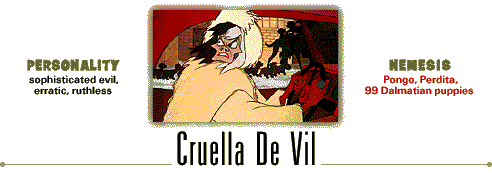Sexism, Spells & Sensible Shoes
The Women in Disney's World
Nancy Snavely
Fairytales can add to that much-needed foundation for dreams, but they can also lead to unrealistic expectations. This discussion will analyze the Disney fairytale and the representation of women within. I will explore both the heroine as well as other female characters portrayed. I will argue that Disney films provoke the idea that the heroine must find love in order to be good - and that a woman's role is either wife, mother, mystic, or evil.
The fiction in these stories serve as an important in-site into how women see themselves and the world they inhabit, which raises questions about women and their identity. Class mobility for women has traditionally meant wealth and power acquired by a beneficial marriage - a sort of vicarious access to strength. Women with actual power, exercised in their own right, are typically portrayed as evil aberrations - perhaps with the perverse desire to make coats out of puppies. Conversely, the unmarried and powerless heroine would still be cleaning up after those messy dwarves.




Above gifs from Disney's website: http://www.disney.com
Bibliography
Bell, Elizabeth; Haas, Lynda; Sells, Laura. From Mouse to Mermaid. The Politics of Film, Gender and Culture. Indianapolis: Indiana University Press, 1995.
Dowling, Colette. The Cinderella Complex. New York: Summit Books, 1981.
Kinard, Amanda Dr. Forbidden Pleasures--The
Popular Romance Past & Present.
http://members.aol.com/akinard2/Romance.html
McGlathery, James M. Fairy Tale Romance. Chicago: University of Illinois Press, 1991.
Warner, Marina. From the Beast to the Blonde. New York: Farrar, Straus and Giroux, 1994.
Zipes, Jack. When Dreams Come True. New York: Routledge, 1999.
*Special thanks to my 4 year old niece, Sierra Korff, for allowing me to access to her vast Disney video collection!